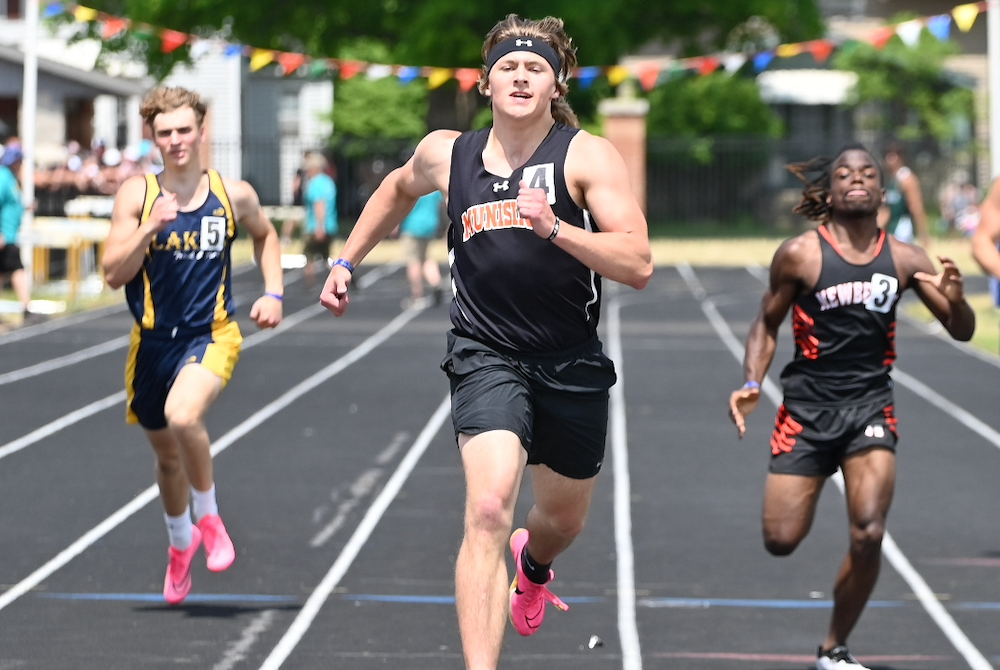
Peramaki Adds to Past Finals Fame by Leading Munising to Team Title
By
Jason Juno
Special for MHSAA.com
June 4, 2023
KINGSFORD – Munising’s Micaiah Peramaki couldn’t really top last year’s Upper Peninsula Division 3 Finals. He became the eighth male all-time to win four events at an MHSAA track & field championship meet.
“I proved myself last year, so it’s a little more of a fun meet this year,” Peramaki said. “But it’s still important for me just to do good.”
And he was excellent again.
He led the Mustangs to the team title with individual wins in the 100, 200 and 400. He was also a part of the winning 1,600 relay team.
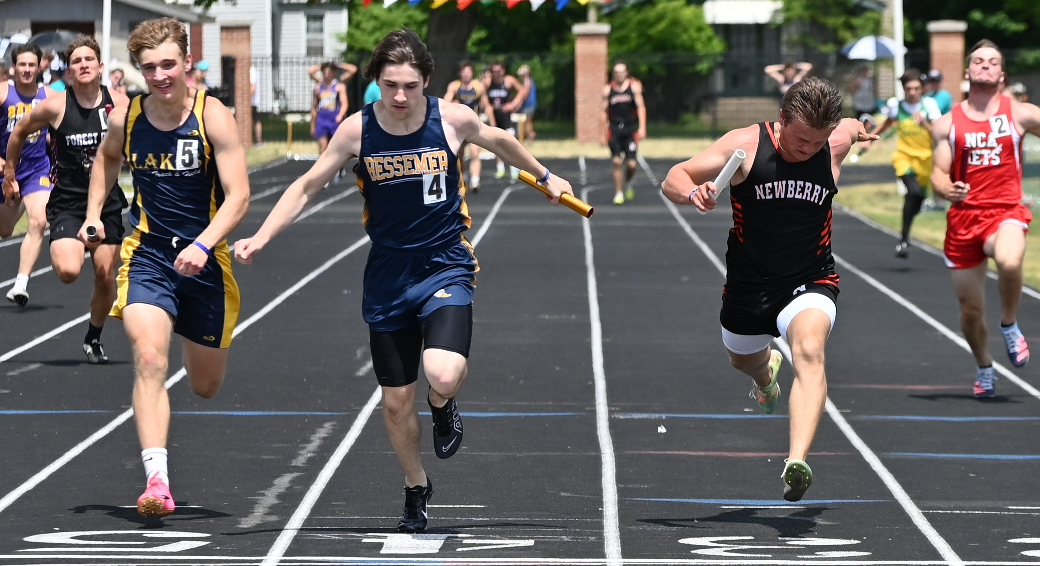 “The 100, I was right next to my brother, Josiah; he ended up getting third. That was really fun actually. We both did really good in that,” Peramaki said. “The 400, I had Aa’Keem (Jackson) from Newberry to watch out for. He pushed it hard in the corner over here, I was prepared for it and I just ran hard from there.”
“The 100, I was right next to my brother, Josiah; he ended up getting third. That was really fun actually. We both did really good in that,” Peramaki said. “The 400, I had Aa’Keem (Jackson) from Newberry to watch out for. He pushed it hard in the corner over here, I was prepared for it and I just ran hard from there.”
Josiah Peramaki repeated with a win in the pole vault. Other members of the 1,600 relay were Kane Nebel, Zack Lindquist and Josiah Peramaki.
Munising won the team title with 103.5 points. Newberry was second with 81, Bessemer third with 52 and Rapid River fourth with 44.
Bessemer won the 400 relay (Tommy Trudgeon, Landon Peterson, Daniel Lis and Vinnie Triggiano). Bessemer also finished fifth in the 800 relay – despite being seeded first – and Trudgeon said he had to make a comeback in the 400 relay, which also was seeded first.
He was behind after a shaky handoff, though. But the 100 meters is probably his best race anyway. He finished runner-up to Peramaki, one-tenth of a second behind him.
“I guess I just had to close like a train,” he said of his leg of the relay. “It feels great, glad to win.”
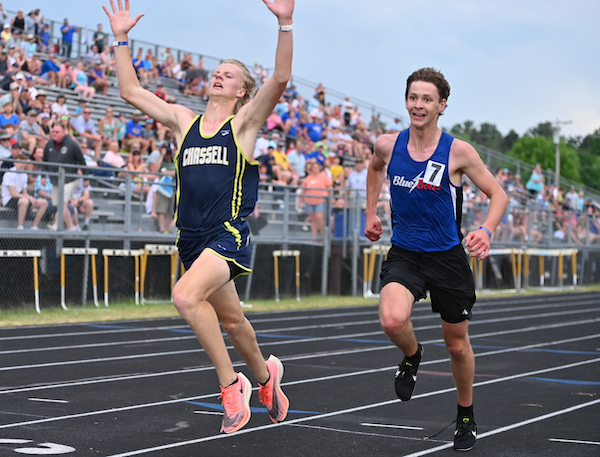 Newberry won the 800 relay (Marco Juarez, Jackson, Matthew Rahilly and Kennedy Depew) and Dollar Bay the 3,200 relay (Joshua Gaunt, Josh Luukkonen, Caleb Kentala and Amos Norland).
Newberry won the 800 relay (Marco Juarez, Jackson, Matthew Rahilly and Kennedy Depew) and Dollar Bay the 3,200 relay (Joshua Gaunt, Josh Luukkonen, Caleb Kentala and Amos Norland).
Crystal Falls Forest Park’s Samuel McKissack won the 110 hurdles, and Newberry’s Chris Hopson was champion in the 300 hurdles.
In the distance races, Dollar Bay’s Norland won the 800, Forest Park’s Gaven Rintala the 1,600 and Chassell’s Kalvin Kytta the 3,200.
The latter race with Norland was so close – Kytta won by seven hundredths of a second – that Kytta wasn’t sure if he was in fact champion or not.
“I got passed by the leader. I tried to stick on him through the rest of the race,” he said. “He got a little gap on me the last 100 meters. I just felt that juice. I think I passed him.”
It turns out he did.
Whitefish Township, which has just 22 students in the high school, went home with a champion for the first time in school history – Seth Mills in the discus. Newberry’s Rahilly won the long jump, North Central’s Dylan Plunger won the high jump and Rapid River’s Kody Goldi took the shot put.
PHOTOS (Top) Munising's Micaiah Peramaki, center, wins the 400 on Saturday. (Middle) Bessemer's Vinnie Triggiano (4) is able to hold off Lake Linden-Hubbell's Matthew Jokela and Newberry's Kennedy Depew to win the 400 relay. (Below) Chassell's Kalvin Kytta, left, and Dollar Bay's Amos Norland run together until the end of the 3,200. (Photos by Cara Kamps/RunMichigan.com.)
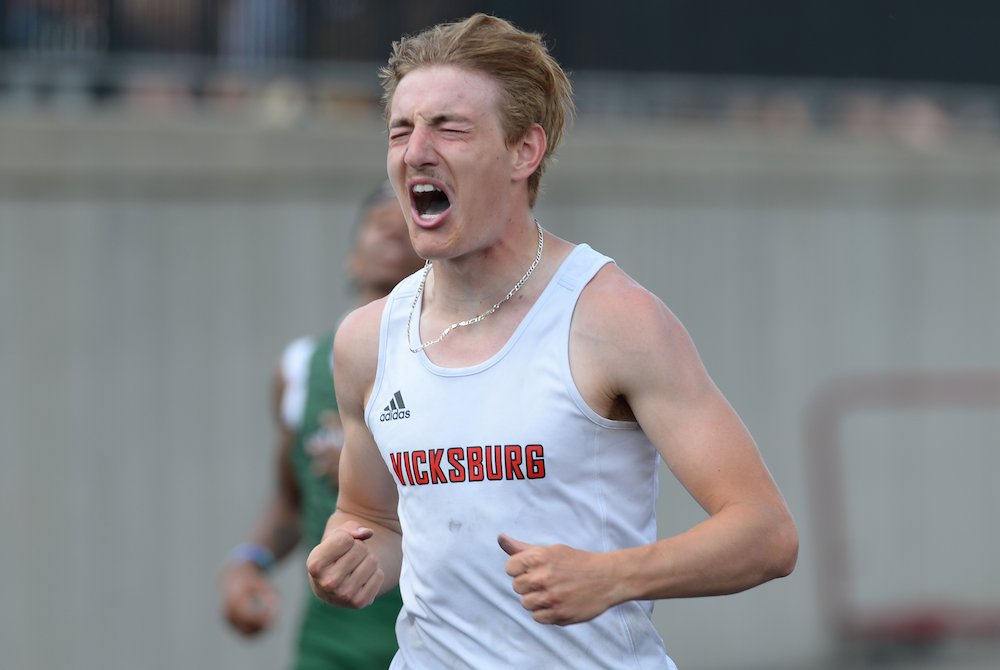
Vicksburg's Wright, Corunna Right On in Claiming LPD2 Championships
By
Steve Vedder
Special for MHSAA.com
June 3, 2023
ADA – If Michael Wright was a baseball player, he probably would've been called out on strikes a year ago.
Instead, the Vicksburg senior can celebrate after winning the 200 at Saturday's Lower Peninsula Division 2 Track & Field Finals at Forest Hills Eastern.
The road to the championship in the 200, via a time of 21.72, was anything but a straight line for Wright. An aspiring baseball player, he was cut from the Vicksburg squad as a freshman. His football career, by Wright's own admission, was "on and off." And then a year ago in his first track meet, Wright suffered a leg injury that virtually ended his season. He did return to finish fifth in the 200 at Finals while helping the 400 relay team to a 16th place.
So there is nothing to realistically explain how Wright found himself in the position Saturday at sweltering Forest Hills Eastern to win a championship. Except for returning this season to break the school record in the 200 four times in two months. Well, that and willpower and simple desire.
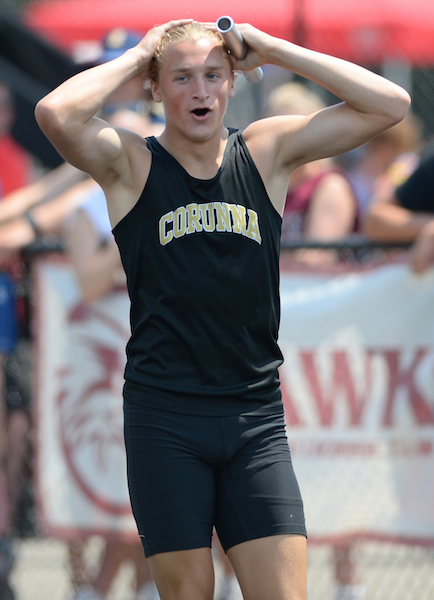 "I knew I could finish high, maybe in the top five. But this is better," said Wright, who credits drinking large quantities of milk for his resurgence. "I looked to football because I didn't think I could bounce back for track. But I overcame the bumps, the obstacles."
"I knew I could finish high, maybe in the top five. But this is better," said Wright, who credits drinking large quantities of milk for his resurgence. "I looked to football because I didn't think I could bounce back for track. But I overcame the bumps, the obstacles."
While Wright was jump-starting his track career, Corunna won the team title with 41 points. Mason and Forest Hills Eastern tied for second with 35. Whitehall was fourth with 33 points, and Frankenmuth fifth with 29 points.
Corunna coach Jeff Sawyer, who had never won a Finals title in 37 years coaching at Owosso and three more at Corunna, said the championship came after little fanfare during the season. Virtually right up until the time Corunna hauled off its first-place trophy, Sawyer said it was never really on his team's mind. The title came after the team managed only a runner-up finish at the Regional.
"We kind of low-keyed it," he said. "We knew scoring 40 points was possible. We lost to Frankenmuth by one point at the Regional. … We were a little disappointed we didn't win, but we had some good times today. We knew it was possible.
"Every day we just come and do what we do. We talk about getting better every day with PRs (personal records). And we're still getting better because we have some tough guys. Just competitive, tough kids. But we were the underdogs."
Corunna had only two firsts on Saturday, in the 400 relay (42.63) and Wyatt Bower in the long jump (22-8½).
Among the individual highlights was Frankenmuth senior Dalton DeBeau, who successfully defended his Finals title in the discus (171-6). He was fifth in that event as a sophomore and after winning a year ago, was considered a good bet to repeat.
"I kind of expected it," said DeBeau, who will compete at Michigan State next spring. "There wasn't a lot of pressure. I knew what had to be done. I threw 160 feet on my first throw to get in the finals, and that helped right away. I knew I could go all out."
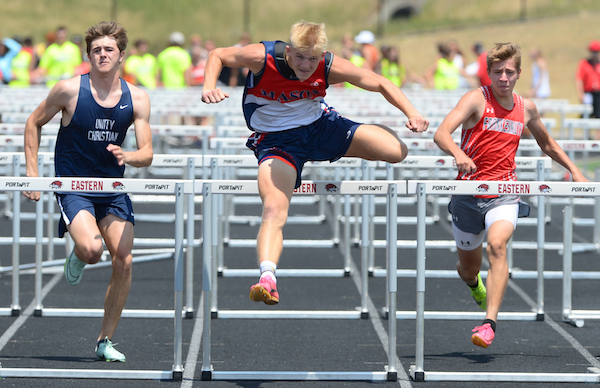 Berrien Springs' Jake Machiniak won the 100 (10.54) while the team also captured the 800 relay (1:28.18). Machiniak said his season hasn't been without its share of difficulties. There was a time when he couldn't seem to come out of the starting blocks smoothly. But beginning with the conference meet where he ran school record 10:73, Machiniak felt himself back on course.
Berrien Springs' Jake Machiniak won the 100 (10.54) while the team also captured the 800 relay (1:28.18). Machiniak said his season hasn't been without its share of difficulties. There was a time when he couldn't seem to come out of the starting blocks smoothly. But beginning with the conference meet where he ran school record 10:73, Machiniak felt himself back on course.
"There were ups and downs. I struggled in the middle of the season," he said. "But my teammates helped me through some difficulties. I came here to finish the job; I knew I could do something here."
Mason's Tyler Baker won the 100 hurdles (14.63) to complete a long journey that included finishing just ninth in last year's prelims. The success was as simple as putting in loads of offseason work.
"I practiced and did stuff about every day," he said. "I might not be the fastest, but I make up for that in form. It's a fine-tuning thing. Everyone wants to be faster."
Mason also got a championship from A.J. Mantel, who captured the 300 hurdles (38.90).
Among other highlights was Forest Hills Eastern senior Aiden Sullivan successfully defending a 2022 title on his own home turf. He won Saturday's 800 (1:53.92).
Adrian won the 3,200 relay (7:39.77), while Grand Rapids Christian took the 1,600 (3:24.49).
Alma had two individual winners in Michael Howey in the shot (55-08) and Jacob Dunlap in the high jump (6-7).
The other champs were Kyle Eberhard of Linden in the 1,600 (4:14.79), Whitehall's Trannon Ayler in the 400 (48.83), Freeland's T.J. Hansen in the 3,200 (9:11.56) and Sam Vesperman of Grosse Ile in the pole vault (15.01). Chelsea senior Jacob Nelson competed in the adaptive 100 (27.28), 200 (57.71) and shot put (6-6).
PHOTOS (Top) Vicksburg's Michael Wright celebrates after winning the 200 on Saturday. (Middle) Corunna's Tarick Bower enjoys a moment after anchoring the winning 400 relay. (Below) Mason's Tyler Baker, center, works to stay ahead in the 110 hurdles. (Photos by Dave McCauley/RunMichigan.com.)

